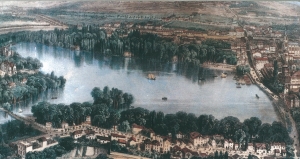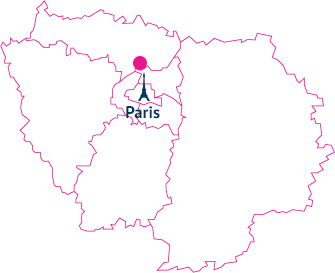Enghien history
The town of Enghien-les-Bains was born in 1850, under the impetus of the law. It takes its name from the Lordship of Enghien, near Mons, Belgium. In 1689, the Prince of Conde was then lord of the land of Montmorency.
It is also lord of Enghien-en-Hainaut. He obtained the king's permission to change the name of the peerage of Montmorency that of Enghien. The new pond of Montmorency becomes the pond of Enghien.
A few years after the Revolution, Montmorency found its original name, but the pond retains the name of Enghien. Also, when hamlet is at this point, he will naturally give the name of Hamlet Enghien. In 1766, an Oratorian priest of Montmorency, Father Louis Cotte, discovers the first sulfuric water near the lake. The first spa was built in 1820. Jean-Baptiste Peligot, director of the Hospital of St. Louis, bought the spa and fits out the pond, which becomes Lake ... The city may adopt its motto: "Dant robur virtutemque fonts" ("The sources that give strength and courage").
In 1823, it carries the waters of Enghien-les-Bains to King Louis XVIII healing of an ulcer in the leg. The news spread, the reputation of the brand new spa is made. The hamlet is a village in the mode where, for the Parisian high society, it is fashionable to go. Enghien-les-Bains is a spa and entertainment. In 1846, the railroad serves the city's north.
More and more Parisians come to walk around the lake, take the waters and entertaining. On August 7, 1850, the National Assembly decides to create a new municipality which will take the name of Enghien-les-Bains. In 1863, the ancient baths are replaced by a new and vast edifice of cures that became one of the most modern in Europe. The growth continues during the Second Empire where the party is permanent (concerts, dances, fireworks every week, boating on the lake ...).
Many individuals move into the luxurious mansions built by the lake: the Emperor's cousin, Princess Mathilde (in Saint-Gratien), the publicist Emile de Girardin, curator of the Louvre museum Frederic Reiset, the painter Ingres, the composer Clairville The Emperor Napoleon III honored with his presence the sumptuous party given by her cousin on the lake.
The first games that appear in Enghien-les-Bains to 1864, the Garden of Roses, are still well behaved (tops, bowling and billiards). But soon, under the leadership of Hippolytus of Villemessant journalist, founder of the Figaro, a circle is created where one plays the game of little horses. A first Kursaal (casino) out of the ground, never completed. The 1870 war has been through it, the Prussians occupied Enghien-les-Bains have committed significant damage. In 1875, Jeanne Bourgeois was born in Enghien-les-Bains. She will see the glory on stage by his nickname Mistinguett.
The new casino building was inaugurated in 1878.
In 1901, achieving a spectacular casino is committed: the prow of a huge white yacht that juts over the lake, with ballroom, theater, grotto, coffee But the construction will be replaced in 1909 by buildings that support the current structure. The theater was rebuilt, it now has an Italian room. In 1913, gambling halls account for two hundred thousand entries. During the First World War, a military hospital is housed in the buildings of the casino that has stopped their usual activities.
In 1919, the National Assembly passed a law prohibiting gambling within 100 km around Paris. Enghien-les-Bains has been severely hit, its activity declines. It was not until 1931 that the law be relaxed.
In 1935, a new Spa replaces the previous one obsolete. It will remain until the beginning of the 2000s.
During World War II, Enghien-les-Bains will quartering regular German regiments of passage. The city is also home to a regional Kommandantur. At the time of release, it will be the scene of violent clashes between German forces and elements of the Second Armored Division of General Leclerc, supported by the local resistance.
In 1988, Lucien Barrière group obtained the concession for the spa and casino. A few years later, he is authorized to operate slot machines. The revenue generated will allow the complete restructuring of the gambling halls and the construction of a new facility of 13,000 m2 dedicated to well-being. For its part, the city will proceed with building a center of arts, multidisciplinary space facing the performing arts, digital arts and visual arts.
The city grew throughout the nineteenth century as an atypical model resulting from the expansion of its thermal activity. Two orthogonal axes of communication and straight draw his plot: the road from Argenteuil to Montmorency, now rue du General de Gaulle, and the railway company's from the north, opened in 1846.
Since 2003, the City hired a procedure for creating area of architectural conservation, urban and landscape in order to extend the scope of protection to homes in many neighborhoods of remarkable architecture (styles Napoleon III, Haussmann, eclectic, Art Nouveau).
Enghien-les-Bains has preserved spa architecture typical of the nineteenth century and the Belle Epoque. Walking through the city, many public buildings and private houses perpetuate the charm of the city: neo-Gothic castles, Swiss chalets, cottages Norman style, neoclassical villas with their mansard roofs, Second Empire buildings, Art Nouveau ornamentation.
Enghien-les-Bains Tourist office and business centre
81, rue du Général de Gaulle
95880 Enghien-les-Bains
Tél. : +33 (0)1 34 12 41 15
- Monday 2-6pm
- Tuesday to Saturday 10am-1pm and 2-6pm
- Sunday and public holidays 3-6pm
(Except January 1, May 1 and December 25)
We need your help to improve the quality of our services.
Please Take a moment to Answer this Survey






